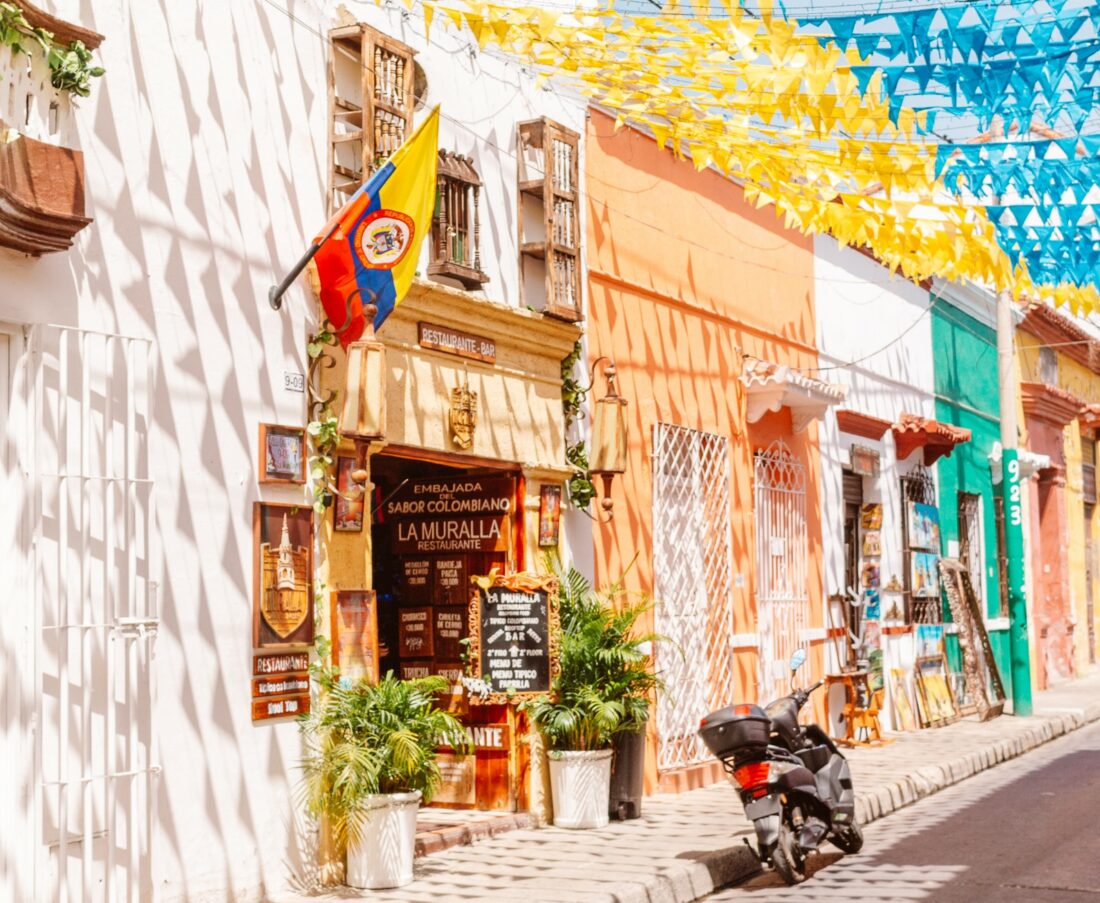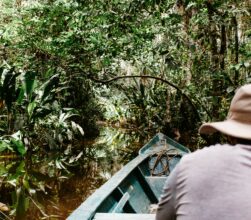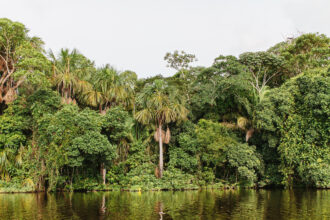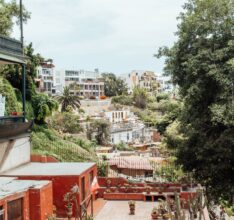For once, we weren’t exhausted getting to a new destination! Our mid-afternoon flight landed without a hitch and we wrangled a cab to our Airbnb smack in the center of Old Town, Cartagena.
Our first view of the famous fortified port city was the massive, softly-lit city walls, gently lapping Caribbean, and blaring of taxi horns. From that moment, we knew we were in for something totally unique.
Cartagena represented a lot of firsts for us. It was our first smaller city (just under 1 million residents), our first hot and humid city (low 90s, 75% humidity), and our first time in a purely tourism-driven destination.
We came away from Cartagena with a split impression. It truly deserves its reputation as one of the most beautiful cities in the world. Narrow streets flanked by colorful, colonial buildings. Carved balconies drenched in vines and flowers. Streets strung with flags, umbrellas, and twinkling lights. Thick stone walls illuminated by blood-red hazy sunsets and grand churches filled with light.
It was also a tough place to visit. Partly because of the small size, partly because of the heat and humidity, but mainly because of overtourism, crowding, and extremely persistent street vendors.
Because of those two sides to the area, I’d definitely recommend exploring Cartagena for a day or two, maybe three. Any more than that I’d invest in Bogotá, Medellín, or one of the smaller destinations like Tayrona National Park.
What did we do?
We had a lovely time exploring Cartagena. Here’s a few of the most noteworthy activities we did. Not mentioned is a lot of strolling about taking pictures, and working in several of the many lovely cafes that dot the city.


Walking around the city
This is honestly the best face of Cartagena. The old town is small, but the number of beautiful little streets, corners, and alleys is staggering. You can’t go more than a block or two without seeing another amazing mural, beautiful block, or lively little square. If you come to Cartagena, you should spend at least one day wandering around admiring the scenery.
Cooking class
We’re doing one in each country we visit, and so far they’ve all been winners. Cartagena was no exception. We learned how to make coconut milk from scratch, coconut rice, patacones (a type of fried plantain and cheese fritter), and a simple and savory seafood stew. We washed it down with mouth-puckeringly sour lulo juce. The food was fresh and simple to make, and we learned quite a few clever techniques from Juliana, our host.

Castillo de San Filipe de Barajas
An impressive fortification designed to resist pirates (including Sir Francis Drake), the English, and the French – this massive castle has enormously thick walls, over 60 gun emplacements, and is studded with mines (to blow up any climbing invaders). It’s also got a series of tunnels and chambers for storing ammunition and supplies, and as a shortcut between sides of the irregularly-shaped citadel.
Isla Tierra Bomba
This was… tough. The island, a short 15 minute boat ride from Cartagena, sports a series of beautiful beaches and an incredible view of the new city. It’s also a haven of scam artists, and many of the beaches are loud, dirty, and crowded with no way out. I went into the gory details of our experience on Twitter, but there is a way to do it properly and have a great time. If you book through one of the hotels (Bomba Beach Club is good), they’ll take care of everything and you won’t have to worry about the hustlers so you can just enjoy the waves and the view.
What did we eat (and drink)?
We chowed down on a ton of good food here. While street food wasn’t quite as omnipresent as in Mexico City, we still found our share of tasty local snacks. The restaurants we went to were generally really good, with a few stand-out excellent ones thrown in.
Celele
This was absolutely incredible, our favorite food from the trip so far. We saved it for the afternoon of our last day, but we’d probably have gone twice if we’d tried it earlier.
Their cocktails were fresh and inventive, with fruit and herbs at the peak of flavor. Their papaya and queso salad was light and interesting, a great start to the meal.
We had a steamed corn bun, filled with savory smoked chicken, and served in a hearty tomato-based broth. Usually smoke can be harsh and overwhelming – this was exquisitely done, a precise balance of rich, hearty, and fresh.
We also got their fish preparation – lightly pan fried, served over a rich and savory mash of green plantains, with a crop of springy, tender green beans on the side. One of my all-time favorite fish dishes ever. Juicy, flaky, and perfectly done.
The triumphant finale was an homage to local sweets. Caramelized coconut ice cream, topped with a thick crust of burnt sugar, and a series of candied nuts and other local sweets. It was perfect – cool, creamy, crunchy, sweet, and with just enough burnt bitterness to keep it this side of cloying. Incredible.

El Barón
Wonderful cocktails, great atmosphere. One of the best spots for a sunset drink in down, and phenomenally delicious appetizers to boot. We got the Rongo, a Polynesian concoction topped with a bouquet of fruit and flowers and a flaming bit of candy, and the Jungle Medicine – a refreshing mix of tropical juices and local liquor.
Pezetarian
Another stand-out restaurant, we went here for a weekday lunch. Their menu was about sixteen pages long, with extraordinary food photography. We picked out a ceviche dish accompanied with little popcorn kernels, and a stir-fried curry rice with seafood. The food was beautifully presented, fresh, and delicious. We also enjoyed a fun little spritz with mango, strawberry, and kiwi. A great restaurant for lighter fare and beautiful, healthy food.
Comida corriente
Comida corriente (“ordinary food”) is a type of home-cooked meal in Colombia. Typically it comes with rice, beans, fried potatoes, salad, and sometimes soup or juice. The main is one of a variety of proteins – it can be a whole fried fish, stewed chicken thigh, steak, pork, or sausage. These meals tend to be extremely cheap and filling, from COP 5000 (around $1.50) to COP 15000 (US $4.50).
Without fail, each one was delicious. Each component was fairly simple, but tasty, and as a whole they were a great way to eat on a budget. We had these from a number of street carts and restaurants and enjoyed them all.
Street food
Cartagena’s street food ecosystem is not quite as vibrant as Mexico City but it’s still got a lot to love. It’s common to see carts selling a variety of heavy, fried meals, as well as pastries, fruits, juices, grilled choriso, Colombian-style ceviche (covered in a ketchup-like tomato sauce), and our personal favorite – arepas.
Arepas are actually Venezuelan, but Cartagena does them amazingly well. They’re cakes of cornmeal, and can be fried, grilled, or even toasted on little burners. We had a few underwhelming ones from various places, but one hungry night we tried just a street-stall classic filled with cheese. This thing was divine – rich, salty, a little sweet, and stuffed with savory, stringy cheese.
One more street food that we had a couple times was the humble bocadillo – a slice of sweet and gummy guava paste, served on its own or topped with savory queso fresco. A wonderful sweet treat to end a meal.
Coffee
The coffee in Cartagena was generally quite good. Favoring cafe express (espresso), cold brew, and tea, we enjoyed plenty of the good stuff while we worked. We really enjoyed the breakfast pastries and frozen coffee at La Esquina del Pandebono (a chain, but a tasty one).
Fun tidbits

You can easily open a coconut by poking a couple of holes with a screwdriver to drain the water, burning it on a gas stove until cracks appear, and then smashing it against the ground. This is how we made coconut milk in our cooking class.

The palenqueras (fruit women) of Cartagena are something like mascots of the region. They represent the first free community of Africans in the new world, from a small town just south of Cartagena. Their eye-catching dresses and indomitable background made them the perfect symbol, both for Cartagena and for tourism in the Caribbean.
The three neighborhoods of Cartagena correspond to the three classes of people that lived in the Old Town. Getsemani was where the slaves and laborers lived, El Central was for the merchants, and San Diego is where the nobles lived.
You might be surprised if you order “jugos frescos” (fresh juice) – instead of fresh-squeezed juice like you’d get in Mexico City, you’ll either get fruit blended with ice or milk, or sour fruit juice mixed with water and sugar (like lemonade).
The tough stuff
We definitely overstayed. We spent a week there, and I think the area warrants at most two or three days. We ended up spending a lot of time in our room, writing, editing, and just lounging around.
Part of the reason is that it’s brutally hot during the day, making it difficult to have an appetite to do too much. Another is that the actual Old Town in Cartagena is fairly small – you can easily explore the whole thing in a single day. If a cruise ship is in port, the town is absolutely packed. You’ll be sharing that picturesque sunset with hundreds of other people.
For me though, the biggest reason was the by-products of tourism there. You can’t walk anywhere without flocks of people clamoring for your attention. There are rappers who blast music into your ears and repeat the same canned lyrics, horse drawn buggies, dozens of restaurant and tour promoters, chachki vendors, street food carts, and drug dealers, all shouting, waving, whistling, and whispering into your ear. I felt constantly overwhelmed by it, and the only real respite was in our room or in some of the nicer restaurants.
We learned to never make eye contact, to constantly shake our heads, to give a firm “no!” to the more persistent ones. Having to have this constant defensive posture made it tough for me to enjoy the best parts of the city.

Despite the tough stuff, we bid Cartagena a fond farewell. The food was outstanding, and the views were stunning. It really is a magical place. Like a hazy Caribbean sunset, you should enjoy it for a moment and then move on.
Saying goodbye to Cartagena, we’re on to the Peru leg of our trip. We’ll get to explore some of the most iconic sights in South America – the Amazon rainforest, and Machu Picchu. But first, a few days in Lima!





































